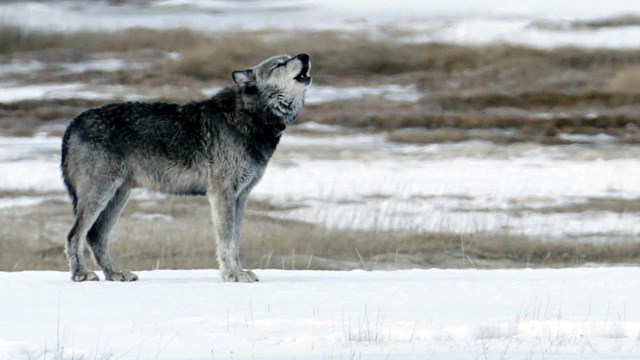
NPS / Neal Herbert The mule deer (Odocoileus hemionus), also called blacktail deer, is an exclusively western species commonly seen in open-brush country throughout the western states. Widely dispersed throughout Yellowstone National Park during the summer, mule deer migrate seasonally and most of the population winters outside of the park. The Greater Yellowstone Ecosystem is home to both mule deer and white-tailed deer. The two deer species are differentiated by their antler shape, and tail size and appearance. 
Number in YellowstoneSummer: 1,850–1,900; winter: less than 400 Where to SeeSummer: throughout the park; Winter: North Entrance area. Size and Behavior
BehaviorAll species of deer use their hearing, smell, and sight to detect predators such as coyotes, cougars, or wolves. They probably smell or hear the approaching predator first; then may raise their heads high and stare hard, rotating ears forward to hear better. If a deer hears or sees movement, it flees. 
PopulationThe State of Montana Department of Fish, Wildlife, and Parks surveys the northern range population outside the park. In 2016 an aerial survey detected 1,1,757 mule deer in the Gardiner Basin area. No surveys are conducted within the park. Since surveys began in 1986 we have observed an average of 66 mule deer (or 3% of the total count) in northern Yellowstone each year. While the relative distribution of mule deer across their winter range has remained similar over the last two decades, the population appears to cyclical increases and decreases. Mule deer populations may decline during severe winters, when deep snow and extremely cold temperatures make foraging difficult. Although researchers estimate that northern Yellowstone has a summer mule deer population of 1,850 to 1,900, fewer than several hundred stay in the park all winter. Unlike elk and bison, many of which remain in the park throughout the year, mule deer are preyed upon by wolves, coyotes, cougars, and bears in the park mostly in the summer. Because of the mule deer’s seasonal distribution, the relative scarcity of white-tailed deer, and the abundance of elk, which are the main prey of wolves, wolf recovery in Yellowstone is believed to have had little effect on deer populations and recruitment. Although the primary causes of deer mortality are winter kill and predation, mule deer and white-tailed deer outside the park are subject to state-regulated harvesting in the fall. Because of their scarcity, little is known about the white-tailed deer that inhabit the northern range, and the population within the park is not monitored. In 2024, chronic wasting disease (CWD) was detected in a radio collared male (buck) mule deer from Wyoming that migrated into the southeast portion of Yellowstone. National Park Service staff and partners will continue surveillance and, if necessary, take action to minimize transmission of this disease.
Visit our keyboard shortcuts docs for details
The Northern Range is the hub of wildlife in Yellowstone National Park. Occupying just 10 percent of the park, it is winter range for the biggest elk herd in Yellowstone and is arguably the most carnivore-rich area in North America. Early management of predators caused dynamic changes to the ecosystem. The reappearance of carnivores on the landscape has had significant and sometimes unexpected impacts on the resident grazers and their habitat. 
Mammals
Home to the largest concentration of mammals in the lower 48 states. 
White-tailed Deer
A common deer on the East Coast, they are scarcely seen in Yellowstone. ResourcesBarmore, W.J. 2003. Ecology of ungulates and their winter range in northern Yellowstone National Park: Research and synthesis, 1962–1970. Mammoth Hot Springs, WY: National Park Service, Yellowstone Center for Resources. Compton, B.B., R.J. Mackie, and G.L. Dusek. 1988. Factors influencing distribution of white-tailed deer in riparian habitats. Journal of Wildlife Management 52(3):544–548. Council, National Research. 2002. Ecological Dynamics on Yellowstone’s Northern Range. Washington, DC: National Academy Press. Frank, D.A. 1998. Ungulate regulation of ecosystem pro- cesses in Yellowstone National Park: Direct and feedback effects. Wildlife Society Bulletin 26(3):410–418. Hill, R.R. 1956. Forage, food habits, and range manage- ment of the mule deer. In W. P. Taylor, ed., The deer of North America: The white-tailed, mule and black-tailed deer, genus Odocoileus, their history and management, 393–414. Harrisburg, PA and Washington, DC: The Stackpole Co. and Wildlife Management Institute. Houston, D.B. 1982. The northern Yellowstone elk: Ecology and management. New York: Macmillian Publishing Co. Mackie, R.J., D.F. Pac, K.L. Hamlin, and G.L. Dusek. 1998. Ecology and management of mule deer and white-tailed deer in Montana. Helena, MT: Department of Fish, Wildlife and Parks. Singer, F.J. and J.E. Norland. 1994. Niche relationships within a guild of ungulate species in Yellowstone National Park, Wyoming, following release from artificial controls. Canadian Journal of Zoology 72:8. Williams, E.S., M.W. Miller, T.J. Kreeger, R.H. Kahn, and E.T. Thorne. 2002. Chronic wasting disease of deer and elk: A review with recommendations for management. Journal of Wildlife Management 66(3):551–563. |
Last updated: April 18, 2025
